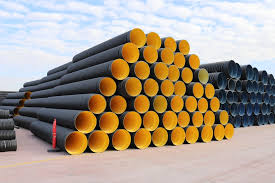Apr . 24, 2024 15:37 Back to list
ABOUT HDPE CONDUIT
ABOUT HDPE CONDUIT
Benefits of HDPE Conduit
High-density polyethylene (HDPE) conduit is the preferred material to house and protect electrical power and telecommunications cables within. It offers unmatched corrosion and chemical resistance, is flexible, durable and available in long reel lengths to reduce joints and installation time. HDPE conduit is available in a variety of sizes, colors, dimensions and lengths.
Flexibility, Ductility, Toughness
- Supplied in long coils on spools or reels, HDPE conduit is compact for shipping
- HDPE conduit follows the trench contours and can be installed around obstacles underground
- Bends and flexes without breakage, even with ground heaves or shifts, over a wide range of temperatures
- High ductility, resists damage during transportation, handling, and installation
- Excellent toughness to withstand jobsite conditions and provide long life underground
- Resists brittleness due to aging or cold weather and retains impact resistance
Continuous Coils
- Supplied in long coils, HDPE conduit installs with fewer joints, and is ideal for horizontal directional drilling (HDD) and plowing installations
- Long coil lengths allow greater flexibility in system design
Coefficient of Friction (COF)
- The COF of HDPE conduit can be 30% lower than PVC raceway
- Improves the effectiveness of lubrication
- Longer pull lengths are possible, so that so manholes are placed farther apart
Resistant to:
- Chemical attack - HDPE is resistance to corrosive chemicals and aggressive soils
- Corrosion - HDPE is non-conducting, does not suffer from corrosion due to soil or water contact
- Bacteria - No host nutrients for bacterial/ fungal growth
Wide Temperature Operating Range
- HDPE conduit remains ductile at low installation temperatures well below freezing, and does not become brittle or shatter
- The maximum operating temperature of HDPE conduit is compatible with the operating temperatures of the power cables
- Power conductors rated at 90°C (194°F) and medium voltage cable rated at 105°C (220°F) are permitted for use with some PE Conduit
HDPE Conduit Types
HDPE conduit products are manufactured in a wide range of colors, lengths, diameters and wall types. These apply not only to the protective conduit but also to innerduct, if present.
HDPE Conduit types include:
- Outside Plant:
smoothwall,ribbed,tracer wire,aerial,Cable-in-Conduit (CIC),innerduct (CIC)
- Inside Plant:
corrugated(riser/plenum),innerduct
Various colors or stripes can be used to identify the network operator or the type of cable used in the conduit such as telecommunications (e.g. orange) and power (e.g. red or black with red stripe).
DN50 HDPE pipes in coils
Conduit Sizes
HDPE conduit standards such as ASTM F2160 specify the dimensions for HDPE conduit. Various sizing systems exist, including IPS types SDR9, SDR11, SDR 13.5, DR 15.5, SCH 40 and SCH 80, "True Sized" and SIDR. For IPS types, wall thickness is described by the Dimension Ratio (DR) which typically ranges from DR 9 to 17 for conduit up to 12" in diameter. The lower the DR number, the thicker the wall, relative to other wall types.
Sustainability
Polyethylene Conduit and Innerduct help sustain important aspects of our lives including communications, power, and electrical networks. HDPE pipe characteristics provide long-term protective conduit where its flexibility aids installation while maintaining excellent toughness and stiffness. Because of HDPE's inherent design, the conduit will protect the ever expanding systems as communities and technologies continue to grow.
Installation Methods
HDPE conduit is flexible which allows ease of installation in existing pathways, yet its stiffness can withstand crush forces at the calculated level for buried applications.
HDPE conduit is installed along highways or roads and in buildings. It is used to protect Power Distribution lines (600V secondary, <69kV primary) and telecommunication lines (network backbones), landline (wireline) and broadban; such as DSL Internet and CATV. The different installation methods are project specific and dictate what strength conduit is used.
Trenchless Technology
Horizontal Directional Drilling (HDD) minimizes the impact to the surrounding area including less interruptions to traffic. This methods installs long lengths of conduit as much as 1,000-ft bores.
- Slip Lining innerduct used to increase capacity of existing pathways
- Pipe Bursting to upgrade service lines
Open Cut
- Plowing allows for long continuous runs along right of ways and the lowest installation cost relative to other methods.
- Trenching is a traditional and simple method where the conduit is uncoiled directly into the open cut.
-
Water Pressure Optimization for HDPE Pipe for Irrigation
NewsAug.07,2025
-
Temperature Tolerance of UPVC Column Pipes
NewsAug.07,2025
-
Root Intrusion Resistance of PVC Sewer Pipe
NewsAug.07,2025
-
Leak Prevention in PPR Plumbing Pipe Connections
NewsAug.07,2025
-
Installation Steps for HDPE Water Supply Pipe
NewsAug.07,2025
-
Cleaning Techniques for Water Lines Under Sink
NewsAug.07,2025


